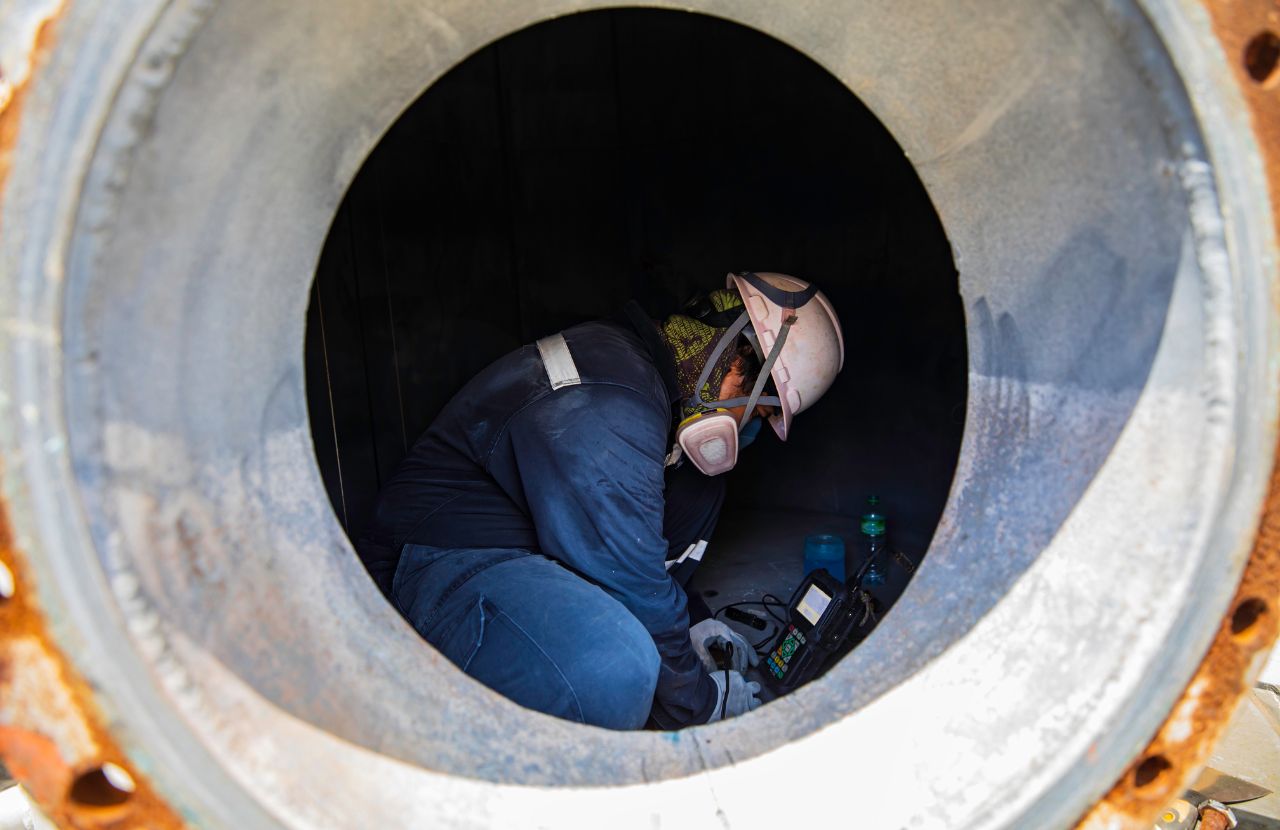
Working in confined spaces can be perilous without suitable precautions in place. Understanding the significance of a confined space risk assessment is crucial for ensuring safety.
In this guide we provide a thorough understanding of the purpose, responsibilities, and key elements of a confined space risk assessment.
What is a confined space?
A confined space is any space that is substantially enclosed and presents a foreseeable risk due to its configuration, contents, or any other hazard.
Confined spaces are not designed for continuous human occupancy and entry and exit is normally difficult. Examples include storage tanks, silos, sewers, pipelines, and enclosed drains.
Confined spaces are classified based on the level of risk they present:
- Low risk. These spaces have adequate natural or mechanical ventilation and do not have hazardous atmospheres. An example is a large, open water tank with clear entry and exit points.
- Medium risk. A medium-risk space contains hazards, such as toxic gases or limited oxygen, but the risks can be managed with appropriate precautions and monitoring. An example is a partially enclosed tank with occasional exposure to fumes.
- High risk: These are spaces with significant risks because they contain hazardous substances or there is a high potential for entrapment or engulfment. Examples include chemical storage tanks, sewage systems, and grain silos.
Why is a confined space risk assessment important?
A confined space risk assessment is the process of identifying and assessing the hazards of working in a particular area, which enables the implementation of control measures to mitigate risks.
The risk assessment helps to ensure that workers are made aware of the dangers and are equipped with the necessary tools, training, and procedures to respond to emergencies effectively.
By fostering a culture of safety and preparedness, a risk assessment enhances workplace safety and supports compliance with The Confined Spaces Regulations 1997, the Health and Safety at Work etc. Act 1974 and the Management of Health and Safety at Work Regulations 1999.
How often should you conduct a confined space risk assessment?
Confined space risk assessments should be conducted before any work commences in a confined space and reviewed regularly to account for any changes in conditions or procedures.
Reassessments should also be carried out whenever there are significant alterations to the workspace, such as changes in the work environment or the introduction of new equipment. They should also be conducted following an incident or in light of regulatory changes.
Who is responsible for conducting a confined spaces risk assessment?
The responsibility for conducting a confined spaces risk assessment lies with the employer.
The Management of Health and Safety at Work Regulations 1999 state that employers must ensure a suitable and sufficient risk assessment is carried out for working in confined spaces. This assessment must be conducted by a ‘competent’ person.
The Health and Safety Executive (HSE) define a competent person as someone who has the necessary:
- Skills: practical and theoretical knowledge relevant to the task.
- Knowledge: understanding of confined space hazards and the associated risks.
- Experience: previous involvement in similar work and environments, providing insight into potential issues and solutions.
It is the responsibility of the employer to make sure that the person they appoint to carry out a risk assessment on their behalf is competent to do so. The assessor may be an employee or a specialist health and safety consultant.
What are the key elements of a confined space risk assessment?
A comprehensive working in confined spaces risk assessment must include:
Identification of hazards
The first step in a confined space risk assessment is to identify all hazards.
Atmospheric hazards
Confined spaces often have poor ventilation, leading to hazardous atmospheric conditions. Atmospheric hazards are:
- Toxic gases and vapours. Gases such as carbon monoxide (CO), hydrogen sulphide (H₂S), methane (CH₄), and volatile organic compounds (VOCs) can accumulate in confined spaces, posing serious health risks.
- Oxygen deficiency. Normal air contains approximately 21% oxygen. Levels below 19.5% can cause impaired judgment, fatigue, and even unconsciousness, while levels below 16% can be fatal.
- Oxygen enrichment. Oxygen levels above 23.5% increase the risk of fire and explosion. Materials that are normally not flammable can ignite easily in oxygen-enriched environments.
- Flammable atmospheres. The presence of flammable gases or vapours mixed with air can create an explosive atmosphere. Examples include methane, propane, and certain solvents.
Physical hazards
These physical hazards in confined spaces can result in injury or death:
- Restricted movement. Confined spaces often have limited entry and exit points, narrow passages, and low ceilings, making movement difficult and increasing the risk of injury.
- Falls. Workers can fall from heights or into lower levels within a confined space. Uneven surfaces and slippery conditions can exacerbate this risk.
- Electrical equipment. Exposed electrical wiring or equipment poses a risk of electric shock or electrocution, especially in wet or damp conditions.
- Machinery. Moving parts of machinery can cause entanglement, crushing, or other injuries if not properly guarded or de-energised.
- Structural stability. Unstable structures or materials within a confined space can collapse, causing entrapment or injury.
Chemical hazards
Exposure to harmful chemicals can occur in confined spaces. Hazards include:
- Corrosive substances. Acids, alkalis, and other corrosive chemicals can cause burns, respiratory issues, and other health problems.
- Toxic chemicals. Substances such as solvents, pesticides, and industrial chemicals can have acute or chronic health effects, including poisoning, respiratory problems, and cancer.
- Dust. Fine dust particles from materials like grain, coal, or metals can cause respiratory issues and even explosions under certain conditions.
Biological hazards
Confined spaces can harbour biological hazards that pose health risks:
- Bacteria and viruses. Pathogens can be present in sewage systems, animal droppings, or decomposing organic matter, leading to infections or diseases.
- Mould and Fungi. Damp and poorly ventilated confined spaces can promote the growth of mould and fungi, which can cause allergic reactions, respiratory problems, and other health issues.
- Animal and insect infestations. Rodents, insects, and other pests found in confined spaces can carry disease-borne organisms.
Environmental hazards
Various environmental conditions can pose risks in confined spaces:
- Extreme temperatures. High temperatures can cause heat stress, heat exhaustion, or heat stroke, while cold temperatures can lead to hypothermia or frostbite.
- Noise. High noise levels can cause hearing damage and impair communication, making it difficult for workers to hear warnings or instructions.
- Poor lighting. Inadequate lighting can increase the risk of accidents, making it difficult for workers to see hazards or navigate the confined space safely.
- Ventilation. Poor ventilation can lead to the build-up of hazardous gases and insufficient oxygen levels.
Risk evaluation
Once hazards in a confined space have been identified, the next critical step is to evaluate the risks associated with each hazard. This process helps in prioritising hazards and implementing appropriate control measures.
The risk evaluation process involves four key components: likelihood assessment, severity assessment, risk rating, and documentation. Please see our article, How to write a risk assessment for more about evaluating risks.
Control measures
Implementing control measures is essential to eliminate or reduce the risks associated with identified hazards in confined spaces.
These measures can be categorised into four main types: engineering controls, administrative controls, personal protective equipment (PPE), and isolation procedures. Each type plays a critical role in ensuring the safety of workers.
Engineering controls
Engineering controls are physical modifications designed to remove hazards or reduce exposure. This includes ventilation systems, gas detectors to monitor air quality, physical barriers like guard rails and safe lighting.
Administrative controls
Administrative controls are work policies and procedures to reduce exposure to hazards. They include:
- Safe work procedures. Developing and implementing standard operating procedures (SOPs) for tasks performed in confined spaces. These procedures detail the steps to be taken, the hazards involved, and the controls to be used.
- Permit-to-work systems. A formal system that requires workers to obtain a permit before entering a confined space. The permit ensures that all hazards have been identified, controls are in place, and necessary precautions are taken.
- Scheduling. Planning work schedules to minimise the time workers spend in confined spaces to reduce their exposure to hazardous conditions. Rotating workers and scheduling regular breaks can help mitigate risks.
- Training and competency. Ensuring all workers have received confined space training and understand hazard recognition, emergency response, and the use of PPE and safety equipment.
Personal protective equipment (PPE)
PPE is the last line of defence when hazards cannot be eliminated or adequately controlled, as above. PPE includes respirators, helmets and hard hats, protective clothing and eye and face protection.
Workers should be trained to use PPE correctly and to check it is in good working order before use. This is especially important when using any breathing apparatus.
Isolation procedures
Isolation procedures are critical to ensure machinery is not accidentally activated or energy released from other sources.
These are isolation procedures:
- Lockout/tagout (LOTO). Implementing a lockout/tagout system to ensure that machinery and equipment are properly shut off and cannot be started up again before maintenance or entry is completed.
- Isolation of energy sources. Ensuring all energy sources (electrical, hydraulic, pneumatic, chemical, thermal) are isolated by closing valves, disconnecting power supplies, or blocking mechanical parts.
- Blocking and blanking. Physically blocking pipes or ducts to prevent the accidental flow of hazardous substances into the confined space.
- Double block and bleed systems. Using a double block and bleed system to isolate a confined space from hazardous substances.
Entry and exit procedures
Establishing safe methods for entering and exiting a confined space is a critical component of a confined space risk assessment.
These procedures ensure that all necessary precautions are taken to protect workers from hazards before, during, and after their entry into the space. Here are examples:
Permit-to-work system
A permit-to-work system is a formalised process to control and document entry into confined spaces. This system ensures that all safety measures are in place before workers enter.
Access points
Clearly marking and maintaining safe access points is essential for ensuring safe entry and exit.
Access points should be clearly signposted to indicate entry and exit routes, hazards, and emergency procedures. Access points must be easily accessible for workers, including those with rescue equipment, free from obstructions and regularly inspected and maintained.
Communication
Reliable communication systems between workers inside and outside a confined space is vital for safety:
- Two-way radios enable workers to maintain constant contact.
- Establish backup communication methods, such as hand signals or alarms, in case of radio failure.
- A designated person outside the confined space must continuously monitor communications and respond to any issues or emergencies.
- Ensuring that all workers understand communication protocols in emergency situations, including distress signals and evacuation commands, is essential.
Supervision
Having a trained supervisor present to oversee entry and exit procedures is crucial for making sure safety protocols are followed.
The supervisor’s responsibilities should include:
- Conducting a pre-entry briefing to review the work plan, hazards, control measures, and emergency procedures with all workers.
- Supervising the entry and exit process, monitoring atmospheric conditions, and ensuring that safety measures are being followed.
- Initiating emergency response procedures, including calling for additional assistance and coordinating rescue efforts.
- Keeping accurate records of entry and exit times, personnel involved, and any incidents or deviations from the plan.
Praxis42 confined space training
Confined space training is a short online course suitable for everyone who works in a confined space. The course provides a fundamental understanding of the hazards of working in confined spaces and ways to eliminate or reduce risks.
Participants will learn about their personal safety responsibilities, the purpose of a confined spaces risk assessment and the importance of following their employer’s safe systems of work. Find out more about confined space training on our website, or contact us today on 0203 011 4242/info@praxis42.com

Adam Clarke
Managing Director (Consulting)
